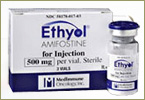Radiobiology > Biologic Interactions > Modifers of Cell Sensitivity > Protectors
Protectors from Radiation-induced Damage
![]()
Radioprotectors
In contrast to oxygen, metronidazole, anti-metabolites, and hyperthermic conditions, certain compounds may protect against radiation-induced chemical damage.
SULFHYDRYL compounds (contain S-H groups) are radioprotective.
- Examples: cysteine, cysteamine, cystamine
Administered to cell cultures or whole animals, these compounds can result in a dose-modifying factor of 1.2-1.5 (i.e., requiring 120-150% increase in radiation dose to affect the same biologic damage as in absence of substance).
Unfortunately, most sulfhydryl compounds themselves produce toxicity at radioprotective doses. Amifostine, a non-sulfhydryl molecule developed by the army during the Cold War, has been used more effectively for radioprotection in humans.

Commercial amifostine (Ethyol).
